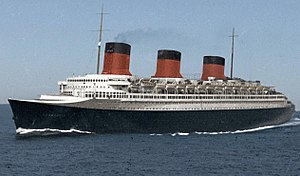
Back SS Normandie Catalan SS Normandie Czech SS Normandie Danish Normandie (Schiff, 1935) German SS Normandie Spanish Normandie Estonian اساس نرماندی Persian S/S Normandie Finnish Normandie (paquebot) French Normandie Croatian
 Colorized photo of the Normandie at sea, c. 1935-1936
| |
| History | |
|---|---|
| Name | Normandie |
| Namesake | Normandy |
| Owner | Compagnie Générale Transatlantique[1] |
| Port of registry | Port of Le Havre[1] |
| Route | Le Havre-Southampton-New York |
| Builder | Chantiers de Penhoet, Saint-Nazaire, France[1] |
| Laid down | 26 January 1931 |
| Launched | 29 October 1932 |
| Christened | 29 October 1932 |
| Completed | 1933 |
| Maiden voyage | 29 May 1935[2] |
| In service | 1935–1942 |
| Out of service | 1942 |
| Identification | |
| Fate | Caught fire, capsized February 1942. Scrapped October 1946 |
| General characteristics | |
| Type | Ocean liner |
| Tonnage | |
| Displacement | 68,350 tons (loaded) |
| Length | |
| Beam | 35.9 m (117 ft 10 in);[1] |
| Height | 56.1 m (184 ft) |
| Draught | 11.2 m (36 ft 7 in) (loaded) |
| Depth | 28.0 m (92 ft) to promenade (strength) deck |
| Decks | 12 |
| Installed power | Four turbo-electric, total 160,000 hp (200,000 hp max).[3] |
| Propulsion | Four 3 bladed on launch – later 4 bladed |
| Speed |
|
| Capacity | 1,972: 848 First Class (cabin), 670 Tourist Class, 454 Third Class |
| Crew | 1,345 |
SS Normandie was a French ocean liner built in Saint-Nazaire, France, for the French Line Compagnie Générale Transatlantique (CGT). She entered service in 1935 as the largest and fastest passenger ship afloat, crossing the Atlantic in a record 4.14 days, and remains the most powerful steam turbo-electric-propelled passenger ship ever built.[4][5]
Normandie's novel design and lavish interiors led many to consider her the greatest of ocean liners,[6][7] and she would go on to heavily influence the French arm of the Streamline Moderne design movement (called the style paquebot, or "ocean liner style").[citation needed] Despite this, she was not a commercial success and relied partly on government subsidy to operate.[7] During service as the flagship of the CGT, she made 139 westbound transatlantic crossings from her home port of Le Havre to New York City. Normandie held the Blue Riband for the fastest transatlantic crossing at several points during her service career, during which the RMS Queen Mary was her main rival.
During the Second World War, Normandie was seized by U.S. authorities at New York and renamed USS Lafayette. In 1942, while being converted to a troopship, the liner caught fire and capsized onto her port side and came to rest, half submerged, on the bottom of the Hudson River at Pier 88 (the site of the current Manhattan Cruise Terminal). Although salvaged at great expense, restoration was deemed too costly and she was scrapped in October 1946.[8]
- ^ a b c d e f Lloyd's Register, Steamers & Motorships (PDF). London: Lloyd's Register. 1935. Retrieved 20 May 2013.
- ^ Bathe 1972, p. 236.
- ^ "Latest Triumphs in Electric Ships". Popular Science. November 1933.
- ^ Ardman 1985, pp. 46–47.
- ^ "Colossus into Clyde". Time. 1 October 1934. Archived from the original on 25 January 2009. Retrieved 19 November 2008.
- ^ Ardman 1985, p. 2.
- ^ a b Floating Palaces. (1996) A&E. TV Documentary. Narrated by Fritz Weaver
- ^ Maxtone-Graham 1972, p. 391.
© MMXXIII Rich X Search. We shall prevail. All rights reserved. Rich X Search